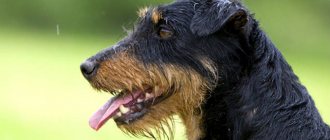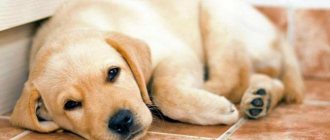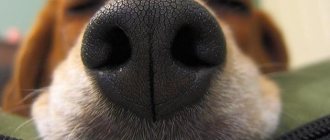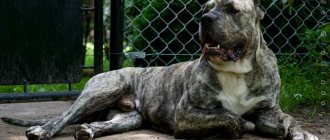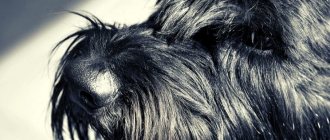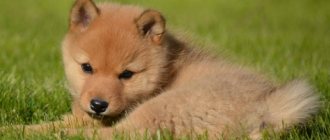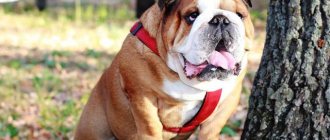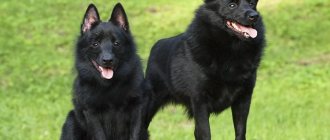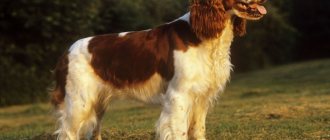Story
At the beginning of the 20th century, the Jagd Terrier breed was developed in Germany. The dog was intended for hunting purposes: to chase an animal and find it by following its blood trail within a certain period of time. Its small size and enthusiastic rage while hunting herbivores and small animals made the Jagdterrier an excellent tracker.
In 1934, the first standards for a small dog were established, which, over the course of a century, changed, and led to the established requirements that dog breeders use today.
The history of the Jagdterrier begins with its Fox Terrier and Old English Terrier ancestors, whose cubs were initially rejected for the resulting black coat color.
But the Germans were determined to create their own German dog symbol at a time of much-needed patriotic spirit for the country after the defeat in the First World War.
The Jagdterrier is a universal breed for hunting any animal.
Choosing a puppy of a hunting breed is not an easy task, because most dogs are used for a specific animal. The novice hunter faces a difficult task.
When choosing your first dog that can work with any animal, you should pay attention to the features and characteristics of the breed.
Hunting with a Jagdterrier will be simplified if the puppy is raised correctly, taking into account the advantages and possible disadvantages of the breed.
Description of the breed
The Jagdterrier is considered a young breed that appeared in Germany at the beginning of the twentieth century. One of the most important features of these dogs is their versatility; they are used in hunting large animals - bear, wild boar, elk, as well as beaver in burrow hunting and birds. But in the countries of the former USSR they are usually used in hunting foxes and badgers.
Another positive quality of the breed is its unpretentiousness. It allows these dogs to be used in all weather conditions at all times of the year. The coarse coat, which even covers the belly and inner thighs, retains heat and protects from snow, wind and moisture.
Breed standard
Dogs of this breed have a dry, lean constitution, thanks to which they are able to cover significant distances. German Jagd Terriers are small in size. Their height does not exceed 40 cm at the withers, and their weight is 12 kg. The Jagdterrier is the only breed for which the proportion of height and chest girth is considered an important criterion. These dogs come in smooth and long hair.
We suggest you read: Hunting with Russian piebald hounds
Description
The public received the German Jagderier warmly, inviting breeders to participate in exhibitions and present their work for public viewing. The pet had not only the characteristics of a hunter, but also an attractive appearance and small size.
No matter how serious a dog is, it is a favorite for many owners not only for its tracker qualities, but also simply because any animal gives joy with its childishness.
The appearance of the pet varies slightly, which allows some species to be presented on the pillow, and others - only as serious hunters, while the height and weight of both must correspond to generally accepted standards in both cases.
In the first option, no matter how trained the dog is, the main thing is its color, length of fur and other visual advantages. Hunters prefer an option that is less picky about grooming - short, coarse hair, minimal height so that the dog can easily climb into a hole and the absence of white spots; this nuance makes the game nervous.
According to their purpose, Jagdterriers are divided into the following types:
- official;
- fighting;
- decorative;
- sentinels;
- hunting
Breed standard (appearance)
The proportions of the dog were created based on practical conditions, therefore the description of the breed and the characteristics of the Jagdterrier are simple appearance and exterior:
- The skull is moderately elongated, wedge-shaped, flat. The muzzle is harmoniously formed, shorter than the head.
- The neck is of medium length, with good muscle tone.
- The body is slightly elongated with a straight top of the body and a strong loin, the length of the body is not much greater than the height at the withers, the belly has a refined curve.
- The chest is deep, the girth should not exceed the height at the withers by 12 cm, the ribs are arched and laid back.
- Teeth – 42 pcs., large, smooth, brightly pigmented. Strong jaws with a tenacious grip and scissor bite are clearly defined.
- The eyes are brown, small, deep-set, spaced far apart, with a straight gaze.
- The ears are triangular in shape, hanging, set high, small in size, not very pointed.
- The front legs are parallel, round in shape with rough, dense pads, have strong bones, dried muscles, elongated slanting shoulder blades, steep forearms and elbows without eversion.
- Hind feet with strong knees, shins, thighs and hard pads on the toes.
- Wool – The covering hair has a coarse, dense texture.
- The tail is straight, curved, like a saber, docked by one third.
Important! The tip of the tail should not deviate towards the back. During a burrow hunt, the owner should be able to pull the angry dog out of the ground precisely by this part. But this parameter does not affect the cost of puppies, since in some countries the docking procedure is completely prohibited.
Popular colors of German Jagd Terriers
Color of the Jagdterrier
There are two variants of the coat: smooth-haired Jagdterrier and wire-haired. The first one has an even covering hair. The Wirehaired Jagd Terrier is distinguished by disheveled guard hair on the chest and a protruding beard, similar to that of the Fox Terrier. The most common color is black and tan. The nose is usually black, but a coffee tint is acceptable for individuals with the same coat color. Also found:
- brown with slightly lighter ends;
- tan and gray;
- black with red and gray;
- completely dark brown;
- smooth-haired completely black.
In both long-haired and smooth-haired coats, dark gold or red tan markings are allowed. They have clear boundaries and are located at the base of the tail, on the eyebrows, the front of the head, the chest, and the ends of the legs. The color is complemented by a dark or whitish mask and white spots in the toes and chest.
Character and appearance
The appearance of the Jagdterrier resembles a Doberman or Rottweiler puppy in color and recumbent ears. According to the description, the breed has miniature dimensions, from 33 to 40 cm in height from the withers, females are slightly smaller than males, from 28 to 36 cm. Weight does not exceed 10 kg.
- Color – black with dark red or brown spots on the face, chest and paws.
- The tail is docked by a third, stands vertically, erect, and when not docked, is rounded with a hook.
- The muzzle is elongated, smoothly transitioning from the forehead. Powerful jaw, with a strongly pronounced chin.
- The ears are set high and turned toward the muzzle.
- Oval, narrowed eyes, black lips.
- The neck is elongated, the chest is wide.
- Small but powerful paws and a strong body.
- Based on the size of their coat, dogs are divided into smooth-haired and wire-haired, when the muzzle and chest are densely overgrown.
The character of the hunting terrier is flexible, loyal, and kind with children. This dog can become an excellent companion and protector. She has high intelligence and is easy to train.
When a pet becomes attached to its owner, it will guard it to the death. But you need to remember that this is not a house dog, and it will not sit locked up. Her temperament is playful, active, requiring an active lifestyle.
When taking it for a walk, it is worth remembering that this is an animal that corresponds to the characteristics of the hunting dog breed, and it will definitely look for “game”, chasing birds and cats. A terrier can coexist with other four-legged animals in the same house, if they are not rodents, but it must be gradually accustomed to cohabitation with a neighbor.
Expert opinion
Anna Abramenko
An avid dog lover. Experience in veterinary medicine since 2009.
Ask a Question
It is not recommended to purchase a breed if the owner breeds pigeons and other poultry - the dog will be aggressive towards it.
Jagdterrier: breed description and characteristics
Sports and Fitness December 29, 2016
Hunting with a wonderful assistant - a dog, especially if it is a Jagd Terrier - is a real pleasure. This breed is considered universal; every hunter can take it with him to hunt professionally or as an amateur.
The dog is very unpretentious at home and at work. They hunt with it any prey - game or land animals. Such dogs are especially useful in the presence of holes, since they are inherently fearless.
In this article we will consider the following issues: hunting with a Jagdterrier, description of the breed and types of hunting with this dog.
This dog excels in hunting this ferocious and large animal. The Jagdterrier is very angry with wild boars for unknown reasons.
The main advantages of a dog over an animal in this case are considered to be noticeable cunning and mobility. Boar hunting with a Jagdterrier has very interesting features in general.
A dog and an animal will never go head-on, because he understands that such a hunt may be his last.
Dogs should begin to be accustomed to wild boars no earlier than a couple of years after birth. By this time, the Jagd Terrier should have acquired minimal hunting experience. At this time, it can be used when hunting small game, as well as some burrowing animals. The danger for such a dog from a wild boar is a high probability of running into fangs that can instantly tear the hunter’s assistant into pieces.
Badger Hunt
It is necessary to bait a Jagdterrier with a badger when the dog reaches 1.5 years of age. This is the time when he already knows certain subtleties of hunting a raccoon or fox. The badger does not differ in any special qualities, therefore, there should be no problems with baiting.
The first task is to locate the burrows of a given animal. Their most likely location is slopes, therefore, they need to be given more attention. The dog is short in stature, easily and quickly moves around the hole and nearby, which means that if the badger is there, then more than half of the job is done in catching the prey.
Fox hunting
You can hunt a fox with a representative of this breed due to the fact that these dogs have incredibly hard hair. It can protect the dog from an animal bite.
A problem that arises periodically during such a hunt is that the fox can hide in its hole and will not come out for several hours.
If she is a fox, then you should let the dog into the hole, making sure to remove the collar so that it does not get caught on roots or other objects inside the hole.
Breed Features
In addition to the fact that the Jagdterrier shows its best side when hunting for wild boar and all the advantages and advantages of the dog indicated above, it is necessary to mention something else - this is hearing.
After she gets used to doing standard hunting duties, she will begin to develop one unusual habit. After the dog hears the sound of a gunshot, his attention will be completely focused on this sound.
At the same time, while hunting, as soon as he hears a splash of water or another sound that indicates hitting the prey, which appears after the shot, it suddenly immediately begins to move in that direction.
If the prey was able to receive a slight wound that knocked it off balance for seconds, there is reason to believe that it will easily become prey for the Jagdterrier. This dog will definitely not miss his chance to catch a bird or animal!
In general, a Jagdterrier hunting a wild boar or another animal given in the article above is a very capable dog that perfectly helps its owner on land and in water.
Therefore, if possible, it is better to get such a dog - use it, since you will not find a more versatile assistant anywhere else.
And due to their ease of care and small size, representatives of this breed are easy to keep in an ordinary city apartment.
The Jagdterrier has a lot of advantages. Representatives of this breed have an amazing ability to work, have good hearing and sense of smell, are very mobile and are easy to train. The breed standard was approved in 1925. The Jagdterrier can be not only an excellent hunting dog, but also an excellent house watchdog.
The Jagdterrier is used in almost any type of hunting. A notable feature of the breed is its concentration on the sound of a shot. He does not behave very kindly towards strangers. The weight of an adult animal is from 9 to 10 kg, and the height at the withers is 30-40 cm. In their appearance, they resemble cute hooligans. In Russia, representatives of the breed are popular. They are loved for their efficiency, unpretentiousness and endurance.
We suggest you familiarize yourself with: Basset Hound - hunting
Breed standard
The Jagdterrier is a strong and resilient dog. The height of this shaggy hunter should not exceed 40 cm for males and 38 cm for females. Weight is allowed no more than 11 kg. The most common color is black and tan, with dark brown being less common. Other options for this breed are undesirable. The coat throughout the body should be dense, coarse, straight, and underneath there should be a thick undercoat.
Experts distinguish between wire-haired and smooth-haired berries. Their main difference is that the first has a “beard” on its muzzle, while the second does not. The ears of these dogs are small, triangular in shape, set on cartilage. Eyes are dark in color. The Jagdterrier's tail, as a rule, is docked by one third or even half.
When describing the Jagdterrier breed, it should be noted that, despite their pretty appearance, they cannot be called “cuties”. From the very first days, representatives of this breed strive to win their place in life and act as they see fit. Because of this, they need an owner who can become a real authority for the dog.
The Jagdterrier is very suspicious of people he meets for the first time. He closely monitors everyone who tries to get closer to him and his owner, and if the guest behaves too impudently, he will not be happy. This dog will not participate in children's games, since endless hugs and caresses disgust him, and the actions of children are incomprehensible.
Other animals, even if they also live in this house, should not try to “build bridges” either, because, in the opinion of the Jagdterrier, any suspicious comrades have absolutely nothing to do on its territory. If you do not pay due attention to raising your tailed friend, then he can grow into a completely uncontrollable, wild animal, which, despite its small size, will cause trouble for everyone.
Hunters note that the Jagdterrier is the most fearless dog in the world when hunting. Neither a huge bear nor an angry boar can stop him. Often, the excitement of hunting and lack of training lead to tragedy - the dog dies from the clutches of an animal that, one way or another, is physically stronger than it. Also, when characterizing the Jagdterrier, breeders warn that due to their strong and independent character, they tend to wander through the forests unaccompanied by their owner.
Education and training
The eccentric disposition of the Jagdterrier requires careful education in terms of character adjustment. The puppy will resist established boundaries, bite and bark, but in the future it will get used to its place and rules in the house.
The dog must be given a clear understanding of its responsibilities, what not to do, where not to go, where to sleep and what to eat. The established rules must be unchanged; violation of them will be perceived by her as an acceptable liberty.
If you miss the period of education in childhood, breaking the character of an adult dog will be difficult and painful. Preparation should begin at 6 months of age.
Uninformed owners feel sorry for the little puppy, allowing him to jump and run around the house, beg for food, throw himself at people, even in a friendly way, being touched by his cheerful character. In the future, such behavior will make him an uncontrollable and aggressive dog, claiming to seize territory.
The owner must convey through his appearance, tone and attitude that this behavior is unacceptable. But you should not go as far as cruelty, beating the dog or locking it in a room, this can completely suppress its character.
What should not be allowed to a young Jagdterrier:
- bite household members on the arms and legs, even when playing;
- beg for food from the table;
- bark and howl while indoors;
- tear furniture, shoes, curtains;
- relieve yourself in the wrong place;
- chase neighbor's animals;
- bark and attack the owner.
The dog must understand the authority of the person; if such behavior is condoned, it will be difficult to train it. Sometimes, desperate terrier owners give their pet for training to a dog handler; as a result, he listens to the mentor, but ignores the owners, realizing that anything is possible at home.
Education and training involve the development of primary skills in puppyhood, which will help in further special training.
Expert opinion
Anna Abramenko
An avid dog lover. Experience in veterinary medicine since 2009.
Ask a Question
Lessons should be given to your pet before feeding or 3 hours after eating. On an empty stomach, he is more aggressive and interested in rewards in the form of food.
To train a guard dog, it is enough to teach it to treat its owners and strangers correctly. If we are talking about training a hunter, then tracker training is carried out on artificial burrows to control actions.
Baiting foxes, moles, hares, ducks and other animals has its own individual characteristics. Training programs are divided into youth, breeding and user. If a four-legged animal is afraid of shots, it is rejected as unsuitable for hunting animals.
“The Jagdterrier is gorgeous in everything, let’s take at least his temperament, even his exterior...”
"Jagd" means "hunting" in German. For this reason, the Jagdterrier is sometimes called the German Hunting Terrier . One way or another, we are talking about universal dogs, brilliantly tracking and catching game on the ground, underground and even in water.
The Jagdterrier was bred by German specialists at the beginning of the twentieth century, and appeared in Russia more than 40 years ago. A new breed had to be created because at the turn of the century many hunters expressed clear dissatisfaction with the work of fox terriers. The shooters argued that these dogs had already lost most of their previously famous useful qualities.
In such conditions, breeders began to purposefully cross the Wire Fox Terrier with the Welsh Terrier, Lakeland Terrier and small hounds. Experts considered their main task to be the development and consolidation of the properties necessary for hunting in the breed. Much less attention has been paid to improving the character of Jagdterriers.
Breed Features
The result is one of the most effective “burrowing” breeds, perfect for hunters. Jagdterriers cope excellently with a wide variety of tasks in the forest, field and on the banks of reservoirs. Dogs can be tasked with hunting foxes, badgers or raccoons in burrows, picking up game and chasing wounded animals along a blood trail.
Jagdterriers are distinguished by rare courage, which makes them suitable for hunting wild boars. These dogs also perform excellently as retrievers, as they can easily find and bring wounded animals and dead waterfowl to their owners. Excellent sense of smell, enviable speed and endurance allow German hunting terriers to chase hares in their tracks with a loud bark.
Based on the type of coat, the breed is divided into wire-haired and smooth-haired dogs. This is where their differences end, and both types are bred and undergo examination at exhibitions together.
Education and care
It is not recommended to have a Jagdterrier as a “dog for the soul”. His bright hunting passion, not realized in his work, can cause a lot of trouble. Jagdterriers are considered one of the most aggressive “burrowing” breeds. They rarely show friendliness towards other dogs and almost never make contact with strangers. German hunting terriers often recognize only one owner and obey only him. Such features allow Jagdterriers to perform good guard functions.
Raising and training representatives of this dog breed is a difficult task. From a young age, a pet must undergo the necessary training and develop skills for living in society. You need to train your puppy with persistence and firmness, but without being too harsh. People who do not have sufficient experience with dogs are better off not adopting a Jagdterrier at all.
In addition, German hunting terriers will be uncomfortable in a city apartment. Dogs will become restless and restless because they require active activities and a lot of physical activity. Jagdterriers love to run and take part in outdoor games. A spacious fenced yard is best suited for these purposes, in which four-legged pets can splash out their extraordinary reserves of energy.
Caring for a Jagdterrier is not difficult. However, it is worth brushing your dog's fur at least once a week. You need to bathe her and treat her with dry shampoo as needed. At the same time, it is necessary to accustom your pet to hygiene procedures right from puppyhood. Thanks to this upbringing, there will be no particular difficulties with him in the future.
From the breed standard
The German Jagd Terrier is well suited for burrow hunting or for raising animals.
The dog's eyes are small, deep-set, and the eyelids fit tightly.
The ears are set high and have a triangular shape.
The coat should be straight and rough to the touch. Its thick layer covers both the body and paws of the German Hunting Terrier . In a smooth-haired Jagdterrier it is usually shorter than in a wire-haired one. However, both varieties are distinguished by a dense undercoat. The wire-haired Jagdterrier grows a beard, while the smooth-haired one does not.
German Hunting Terriers are most often black or dark brown in color. There are brown, red or yellowish tan markings on the chest, paws and muzzle. There are also Jagdterriers with a dark or light “mask” on their heads. There may be small white markings on the chest and toes.
The tail of German hunting terriers is usually docked, leaving less than half of the original length. Most often in dogs it is slightly tilted back.
The average height of an adult male is up to 40 cm at the withers, a female is up to 38 cm. The weight of a “male” dog is 9-10 kg, “female” - 7.5-8.5 kg.
Yaroslav Osetrov, Krasnoyarsk.
Photo by Svetlana Mironova Note
Jagdterrier health
German hunting terriers are considered one of the strongest and hardiest dog breeds. They rarely have health problems. Scientists also have not identified a predisposition to serious hereditary diseases that would be transmitted from one generation of Jagdterriers to another. However, owners should not sit idly by and neglect all the necessary vaccinations and means of prevention against parasites, since hunting dogs, due to the specific nature of their activities, are often at particular risk.
Alarming symptoms indicating a possible illness in the German Hunting Terrier are lethargy and weakness, a sharp decrease in energy and refusal of usual treats and favorite games. In such a situation, it is recommended to quickly show the dog to a veterinarian, who will determine the cause of the problem and select a course of treatment, if required.
Owners must also follow feeding rules in order to save the Jagd Terrier from disturbances in the digestive system, which can lead to damage to internal organs. Particular attention should be paid when hunting in cold weather near rivers and lakes. Even a Jagdterrier can get a cold if it stays in the water for a long time, looking for game.
Where to keep a hunting terrier
The dog is very sensitive to air quality. She should not be kept in small rooms with poor ventilation. The dusty air of small rooms negatively affects the well-being of Jagdterriers. The atmosphere of megacities, filled with car exhaust gases and emissions from large enterprises, has a similar effect.
If you have to keep a German hunting terrier All experts agree that the kitchen would be an extremely bad choice. It is best to place the Jagdterrier in a spacious corridor, laying a thick rug on the floor to protect the dog from the cold. However, coziness and comfort gradually make the dog pampered and less adapted to the harsh conditions of hunting.
Experts recommend keeping your Jagd Terrier outside the home if possible. Thick six allows the dog to calmly tolerate cold temperatures down to minus 20 degrees. But before the onset of serious frosts, it is better to insulate the booth by placing a very thick layer of hay or straw on the floor. In summer, on the contrary, it is advisable to protect the dog from overheating. Prolonged exposure to bright sun without a refreshing wind threatens your dog with heatstroke.
When arranging the booth, you also need to take into account the soil structure. Clay soil does not allow water to pass through very well, so after rain, unwanted dampness will remain for a long time. For the booth, it is better to choose an area with sandy soil, which will quickly absorb moisture and dry out.
Nutrition
Adult Jagdterriers are usually fed twice a day, puppies - three times. After the hunt, dogs are given an additional hearty meal. Dogs living in kennels should receive portions in winter that are approximately one and a half times larger than in summer. At the same time, dogs need a significant amount of clean water every day.
For rapid development, German Hunting Terriers require fresh meat - lamb, horse meat or beef. It is advisable to include canned food in your diet less often. Jagdterriers also willingly eat fish, eggs, cottage cheese, vegetables, cereals and bread. It is necessary to ensure that dogs receive the required amount of proteins, fats, carbohydrates, vitamins and microelements every day. A nutritious diet will improve the health of four-legged hunters and allow them to remain active and energetic for many years.
Features of hunting
When a Jag Terrier is taught hunting skills, certain requirements are established for different types of baiting animals. The dog must be able to follow the blood trail 400-500 m from the prey and recognize the smell after three hours after the killed game ran by.
When hunting a hare, the German terrier is trained to pursue with a voice no less than 300 meters away; the hound species is used for these purposes. When an animal runs into a hole, the dog must grab it there and hold it for at least two minutes until the hunters arrive.
When walking towards a hare, the animal is deceived by the terrier’s lower speed and slows down, giving it a head start.
After training, the dog is tested and receives a category for stalking of I-III degrees.
For hunting, most often they take males, females are less hostile to game. In pursuit of a badger, the terrier digs a hole and barks continuously until the hunters come to dig out the animal. After this, the hole is filled back up.
The peculiarity of duck hunting is to search for game that has been hit with shot; this eliminates a large percentage of wounded birds. When hunting wild boar, the terrier's task is to chase the downed animal and hold it back by barking.
A large wounded boar is dangerous for a small dog and can attack and injure with its fang. Tracking is carried out until Wednesday, even in light snow, along the black trail.
Expert opinion
Anna Abramenko
An avid dog lover. Experience in veterinary medicine since 2009.
Ask a Question
With large snowdrifts, the dog is ineffective, as it will fall into the snow.
Types of hunting with a Jagdterrier
The breed can safely be called universal. There are no limits to the innate instincts of representatives of this breed. They are ideal for hunters living in city apartments. This relatively small dog is very unpretentious and can be used for almost all types of hunting.
Burrow hunting
Burrow hunting can be carried out on various animals. You cannot let a dog into a hole without special training. Young dogs with unformed psyches should not be driven into holes. They begin to hunt with them in burrows after the dogs are one year old, and with the badger after 1.5 years. Training is conducted on various types of burrowing:
- driving an animal out of a hole . The dog is launched underground and it chases the animal towards the hunter;
- taking locally . The dog crushes the animal underground on its own and pulls it to the surface.
One of the most difficult species is hunting a badger with a Jagdterrier. With it you have to open the badger's hole. During the opening, the dog barks at the animal, does not let it out of the hole and does not allow it to dig in. The badger baiting begins with the search for its burrows. You can find them on hillsides. Thanks to its mobility, lightness and small stature, the Jagdterrier very quickly drives an animal superior to it in strength and power into a corner. When an animal is detected, the dog begins to bark loudly, notifying the hunter of his find.
Hunting foxes in holes with a Jagdterrier requires compliance with complete silence. The dog is lowered into the hole without a collar. Her muffled bark is a signal to the hunter that the animal has been found. The cunning and cautious fox always has several exits from the dungeon, so they hunt it with a group of hunters.
Another burrowing animal is the raccoon. After the dog drives the raccoon out of the hole, it does not run far. This allows hunters to find it very quickly. This happens most quickly in winter. The tracks it leaves in the snow help in finding the animal.
On the boar
Hunting wild boar with a Jagdterrier can be dangerous for a young dog. Baiting a large and dangerous animal begins after it has gained experience and reached at least 2 years of age . Hunters with dogs form a chain and begin a hunt for the wild boar. Excellent sense of smell allows the Yard Terrier to quickly find a wild animal.
The found boar is surrounded by angry dogs and held in place until the hunters approach. In such a situation, you need to shoot with extreme caution so as not to hit the excited dogs.
For the hare
In hunting hare, Jagdterriers are inferior to hounds. Their disadvantage in this type of animal baiting is that they only chase the hare into the first circle. After the long-eared animal jumps into the far circle, the dog stops chasing it. He just sits down and waits for his owner. In terms of endurance when running long distances, the Jagdterrier cannot compete with hounds, which are capable of not only catching up, but also driving a hare.
For waterfowl
This method of hunting requires serious breeding selection. For this purpose, the Jagdterrier is trained using a special training method. He is accustomed to extreme situations.
Without such training, it will be impossible to force the dog to jump into icy water or thick reeds after shot game.
Among the Jagdterriers you can find excellent divers. Not only can they swim, but they can also dive for game if necessary. They start cooking for Jagdterrier duck in the summer. At this time, the water in the reservoirs is warm and the dog is not so afraid to get into the water. Seeing game, the hunter tries to set the dog on it. This is how he develops an attack reflex.
On the beaver
Beaver hunting, like fox and raccoon hunting, can be done in different ways. The hunter can signal the dog to poison the animal with his voice or with a signal shot. The specificity of the hunt is that the Jagdterrier drives the beaver out of the hole into the water or simply finds its home, at the exit of which a trap is installed.
Beaver baiting training takes place over several seasons . It is very important that the dog behaves quietly, carefully during the hunt and does not make a single sound. Sometimes a beaver that comes out of a hole is simply killed in the water with a club.
Care and maintenance
Caring for a Jagdterrier will not take much time from the owner. But despite the smooth coat, it also needs to be brushed with a brush or rubber glove every week. After bathing, do not let the dog go outside for 2 hours or do it at night so that the fur is completely dry.
You also need to wipe your dog's eyes every 14 days or when the nitrous starts. This must be done with cotton wool or a soft cloth soaked in chamomile solution or tea leaves. It is also advisable to check the ears for dirt and dust.
After walking and being in the forest or thick grass, it is recommended to inspect the terrier for ticks. They are usually hidden in the ears, armpits, chest and neck. It is better to treat the dog for parasites before taking it out for a walk.
To do this, you need to purchase a collar or anti-ectoparasite remedy, and apply a drop on the withers, refrain from bathing for 10 days, and do not allow children to pet the animal for 1 hour after treatment.
Trimming unsharpened claws should be regular. The dog also needs to have the claw on its big toe cut off. If it grows, it could injure her and cause her to limp.
Expert opinion
Anna Abramenko
An avid dog lover. Experience in veterinary medicine since 2009.
Ask a Question
Jag terriers love to dig under fences, and if this is not monitored, they can run away.
Keeping a pet at home, namely in an apartment, requires walking the dog 2 times a day for 1-2 hours.
Staying outside should be active, with elements of training. At the same time, you cannot feed the dog before walking it, while it is outdoors; it must spend as much excess energy as possible in order to behave calmly and obediently at home.
Hunting breed Jagdterrier: photos and tips
The Jagdterrier was bred in Germany in the 30s of the twentieth century. The breed appeared in Russia in the seventies. Male Jagdterriers reach a height of 30 to 40 centimeters at the withers and weigh about 10 kilograms. Based on appearance, the breed is divided into smooth-haired and wire-haired, but this division does not affect the breeding or participation of dogs in exhibitions.
Character
The Jagdterrier is fearless, purposeful and stubborn. To raise such a dog you need an unyielding will and a steely character. The Jagdterrier is distrustful of strangers. Like all hunting dogs, the Jagd Terrier requires regular exercise.
The Jagdterrier is a determined and vicious hunter. Thanks to these qualities, the Jagdterrier is ready to fight for its prey and owners at any time. Like any terrier, the Jagd is very loyal to his owner, but despite this, he is not at all suitable for the role of a city dog. The Jagdterrier requires constant training. Given the innate traits of his character, only experienced hunters own such dogs.
An aggressive dog can cause problems with other animals and even people.
Pritivka
The training of a puppy begins at 6-7 months with a raccoon. For initial training, it is recommended to use an artificial hole, this makes it easier for the owner to control the dog’s actions. As a rule, baiting a Jagdterrier is not difficult.
After being baited with a raccoon, the puppy is taught to hunt foxes, and by the age of one and a half years, to hunt badgers.
Males cope better with baiting than females. It is enough for them to be baited once or twice, and they cope with the tests.
Hunting with a Jagdterrier
Working in a hole
The Jagdterrier is considered a burrowing breed, so the main use of this breed is burrowing. With the Jagdterrier they hunt raccoon, fox and badger. A well-trained dog finds prey, crushes it and pulls it out of the hole. This applies to the raccoon and fox.
When hunting a badger, the hunter needs to open the hole. At this time, the dog does not allow the animal to bury itself and barks at it. Often, a Jagdterrier can crush an animal two or three times its weight. A good representative of the breed boldly attacks the prey and holds it in a death grip.
Working on a blood trail
The Jagdterrier proved to be no worse than huskies in blood trail tests. The indicators for scent and search of Jagdterriers are much higher than those of representatives of other hunting breeds. With proper training, Jagdterriers work well on ungulates.
Boar hunting
We suggest you read: Can cats eat salt?
Agile and aggressive Jagdterriers work well with wild boars. In terms of courage and dexterity, they are ahead of huskies.
Under natural conditions, when hunting wild boar in deep snow, the performance of Jagd Terriers may decrease.
When hunting wild boar, you can use Jagdterriers together with huskies. In such a union of two breeds, the chances of getting prey are much greater, and the dogs complement each other well.
Waterfowl
Jagdterriers, being natural hunters, love to swim and dive. They do a good job of hunting waterfowl. In particular, they have no equal in searching for and serving shot game.
The Jagdterrier can be used in hare hunting. However, here they are much inferior to the hounds. As a rule, the Jagdterrier chases the hare on the first small circle, but the dog may not go on the second.
The Jagdterrier is a breed bred specifically for hunting with German pedantry. It combines the best hunting qualities, which allows representatives of this breed to outperform other hunting dogs in tests.
Owner reviews
"The Trouble Dog"
I loved my yag very much. Smart, beautiful, picky, well-mannered. But! Very temperamental. Constantly overwhelmed with emotions.
Other owners say their dogs were aggressive, chasing cats, and fighting with other dogs.
Moreover, jagd can strangle a Rottweiler, and some owners had to pay for killed dogs. You cannot keep such a dog without constant hunting.
Before the Jagdterrier, I had two dogs: Kerry and Drathaar. I go hunting with friends, but only for birds. Although hunting trips are rare, we walk for two hours every day. If you don't have time for long walks with your dog, don't get a Jagdterrier.
Jagd is an excellent dog for a hunter, but he is independent, stubborn, and tries to dominate children. The owner needs a calm and strong owner. The dog is suspicious with strangers. If there are guests at home, the dog is muzzled. He looks like a harmless little dog, but he can bite if something seems wrong to him.
"The Real Huntress"
The father got himself a tiny cute puppy. From the cradle the dog was feisty, he grabbed everything with his teeth and held it with a death grip. A very complex breed, such a dog needs to be trained correctly.
She must have one owner. No baby talk should be allowed with the yagd, this is primarily a hunting dog. The puppy grew up very quickly. The father takes the yag with him hunting and is very pleased.
It is good at getting game out of the water and badgers out of holes.
Jagdterrier nutrition
You can feed your pet professional food or regular human food.
Adjusting the diet for puppies by month:
- up to 2 months they should receive 5 meals a day with an interval of 3 hours;
- from 2 to 4 – every 4 hours;
- from 4 to 8 – 3 times;
- adult dog - feed twice a day.
The diet should include:
- raw beef scalded with boiling water;
- boiled porridge;
- dairy products;
- cottage cheese;
- yogurt;
- fruits and vegetables;
- bones, cartilage;
- milk (for puppies).
What not to give:
- sweets (they harm teeth and the dog gains weight);
- smoked meats, sausages;
- fermented milk products with a fat content of more than 9% (affect the liver);
- veal (causes diarrhea).
In case of stomach upsets, it is advisable to include foods containing starch (rice, potatoes) in the diet. The pet should also be provided with round-the-clock access to clean water. In the winter season, you need to add sunflower oil to your food; it also helps with the formation of cracks in the paws.
Health and illness
The Jagdterrier does not inherit any genetic abnormalities and is considered the healthiest dog in the world. The only thing worth monitoring regularly is the presence of cracks in the paws, fractures and splinters.
Since the dog is often in the forest and thickets, it is necessary to examine it for the presence of parasites, because they cause big problems and diseases. The terrier should be vaccinated against rabies, this is especially important when in contact with wild animals.
Otherwise, you just need to monitor quality nutrition, an active lifestyle, and the dog will be healthy all the time.
Dog behavior that requires you to seek medical help:
- refusal of food;
- passivity in the game;
- the pet sleeps constantly.
Jagdterrier hunting for wild boar. Description of the breed, features and interesting facts
Hunting with a wonderful assistant - a dog, especially if it is a Jagd Terrier - is a real pleasure. This breed is considered universal; every hunter can take it with him to hunt professionally or as an amateur. The dog is very unpretentious at home and at work. They hunt with it any prey - game or land animals. Such dogs are especially useful in the presence of holes, since they are inherently fearless. In this article we will consider the following issues: hunting with a Jagdterrier, description of the breed and types of hunting with this dog.
Lifespan
Responsibility for how long a German Jagd Terrier will live depends on the owner. The breed is distinguished by good health and endurance, but frequent injuries and fractures negatively affect the body and immunity in general.
With proper care, dogs live up to 12-15 years.
The main thing is to treat diseases in a timely manner, monitor nutrition and protect your pet from parasitic influence.
Pros and cons of the breed
When a future conqueror of forests and fields is faced with the choice of which dog is best for hunting, and the scales tip in favor of the Jagdterrier, it is necessary to take into account all the pros and cons of representatives of this breed.
Advantages
A lot of advantages make this breed an indispensable hunting assistant.
- The Jagdterrier is tireless and fearless when hunting at any time of the day or night, despite the cold, hurricane, pouring rain and even the end of the world.
- Unpretentious in matters of feeding and maintenance
- She is in good health and has virtually no hereditary diseases.
- Small body size
- Can become an excellent guard and friend for all family members.
- You can go hunting with a Jagdterrier, both for large animals (wild boar, badger) and for waterfowl.
Flaws
You should not get this breed if you do not have time for active long walks and training.
- The Jagdterrier cannot be kept at home as a “couch dog” at all.
- Training a Jagdterrier is not easy, but necessary.
- Requires a lot of physical activity.
- Unfriendly with other pets.
Hunting with a Jagdterrier is a very exciting process, where the dog, being too carried away by the prey, can get seriously injured. Take care of your pet and good luck on the hunt!
Rules for choosing puppies
You need to know for what purpose the dog is being purchased in order to pay attention to certain qualities. When choosing a dog for hunting, you should give preference to a Jagdterrier puppy that has an aggressive character and will not sit quietly in your arms.
He must break free and bite - only such a baby grows into hunters who do not let go of their prey.
A calmer puppy will be suitable as a pet or for keeping in an apartment - there will be no problems with him. In both cases, babies should be well-fed, playful and active.
If the puppy looks wild and thin, then there is a possibility that he has worms or was not fed enough, this affects the development of the skeleton and muscles. You should check your ears, teeth and bite for cleanliness. According to the standards, dogs with malocclusion are not suitable for hunting.
Content Features
The best option for a Jagdterrier would be to keep it in an enclosure, subject to regular walking and the opportunity to go hunting. It is worth noting that dogs quickly adapt to life in a house or apartment.
The Jagdterrier is suitable for keeping in an apartment, subject to good physical activity and the implementation of hunting instincts.
A Jagdterrier puppy needs an eye and an eye. If you get distracted for a while, your favorite slipper will be irrevocably damaged. And not just slippers. A Jagdterrier at any age, if he is not busy with useful work, likes to spoil things and acquires other bad habits. If the puppy is not accustomed to a crate or playpen with high sides, he may begin home repairs on his own.
It is recommended to own a Jagdterrier only for avid hunters or people who lead an active lifestyle and love long hours of walking. The Jagdterrier is not suitable as a decorative dog or companion for older people.
The Jagdterrier is very active and energetic, needs many hours of walks without a leash, but not within the city limits, where he can jump out onto the roadway or get into some other trouble by chasing a neighbor's cat. Jagd wants to be free and independent, but for the owner to be somewhere nearby.
Nutrition
The Jagdterrier often prefers natural food, but the dog can also be accustomed to ready-made food if this type of food is preferable for the owner and he is ready to buy higher-quality food for the dog. The Jagdterrier eats a lot for its size, but this is justified by its high energy costs. During periods of active physical activity, before hunting or in the cold season, the calorie content of food is increased. The Jagdterrier is not prone to overeating and rarely gains excess weight at a young age, but it is still recommended to feed it in portions at the same time. On walks, the yagd is not averse to eating various waste and everything that its beloved owner will never allow to eat at home. It is almost impossible to wean a dog from this habit, so you have to constantly monitor it.
Care
The Jagdterrier is absolutely not demanding in terms of care. It is enough to periodically brush the dog, clean the ears, wipe the eyes and trim the nails. They bathe rarely, usually no more than once every three to four months. This does not apply to rinsing paws and belly after walks.
Puppy cost
When purchasing a baby German Jag Terrier, a rational question arises - what determines the price of this breed. Puppies with impeccable heredity, suitable for exhibitions and participation in various competitions, cost from 25 to 30 thousand rubles. At the same time, with the purchase of a dog, documents about vaccinations, parents and a passport must be purchased.
For hunting purposes, a dog has a lower cost, since it is smaller in size, and less attention is paid to the quality and color of the coat. The price will vary from 15 to 20 thousand rubles.
Simple dogs, bred without taking into account genetic characteristics, suitable for the role of a pet or watchdog, cost from 5 thousand rubles. This does not mean that the four-legged friend will have poor health and sensitivity, he also corresponds to the characteristics of his breed, he just may not meet some standards.
To reject a dog, it only takes a few centimeters of shortness in height or the presence of white spots on the coat. Otherwise, the terrier will have the same set of genes as the breeding dog.
Interesting facts from the life of dogs
- When the first representatives of Jagdterriers were bred, most of the individuals were rejected due to inconsistency in color. Breeders wanted to achieve a pure black coat color. Due to superstition, two- and three-colored individuals were considered to bring bad luck.
- At the beginning of the twentieth century, the terrier was called the “German devil” for its ferocious character and ability to pursue game to the very end.
- The dog is in excellent health despite the artificial breeding of the breed.
- Without training, street dogs become aggressive and dangerous to people.
- The speed of pursuit of an animal is higher for yagterriers than for greyhounds.
- Despite the small size of the animal, they even go after bears with it.
Feature of the breed
The Jagdterrier has a lot of advantages. Representatives of this breed have an amazing ability to work, have good hearing and sense of smell, are very mobile and are easy to train. The breed standard was approved in 1925. The Jagdterrier can be not only an excellent hunting dog, but also an excellent house watchdog.
The Jagdterrier is used in almost any type of hunting.
A notable feature of the breed is its concentration on the sound of a shot. He does not behave very kindly towards strangers. The weight of an adult animal is from 9 to 10 kg, and the height at the withers is 30-40 cm. In their appearance, they resemble cute hooligans. Representatives of the breed are popular in Russia . They are loved for their efficiency, unpretentiousness and endurance.
Reviews
Sergei: “We got two Jagdterriers to guard the country house. Although a small dog, she is angry with everyone who approaches the house, does not let anyone near her, and even barks at cats running along the fence. The downside is a lot of noise, it reacts to everything that moves.”
Dmitry: “We decided to take a young Jagdterrier hunting for the first time. They caught a mole, and the dog drove it so deep into the hole that they could barely pull it out by the tail to pick up the animal. The dog is smart and angry, but sometimes uncontrollable.”
Olga: “Since childhood, we raised a baby German terrier to guard the house. My daughter loves to walk with him, she is 12 years old. When they leave, I am calm for her. The dog loves her and protects her from everyone, even from cats and pigeons. He eats everything we give him, the main thing is not to feed him from the table, otherwise the dog starts to get impudent and howl.”
Photo and video review
The photo shows a baby German Jagd Terrier. The video review is dedicated to the training and preparation of a young yag.
A big helper is hidden in a small body. Purchasing a German Terrier as a pet is not only a profitable investment in hunting and home protection, but also raising a reliable friend and comrade who will repay with gratitude and love.
